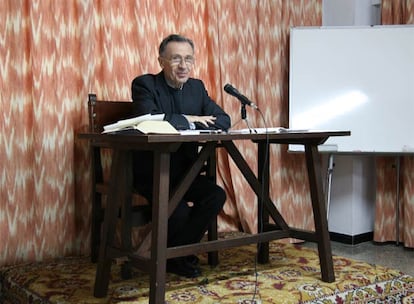The Pope replaces the head of the Doctrine of the Faith, the body that deals with abuses
Francis replaces Spaniard Luis Ladaria at the head of the department dealing with the theological essences of the Church and pederasty and replaces him with Argentinean Victor Manuel Fernandez

The Congregation for the Doctrine of the Faith, which until very recently constituted the Vatican’s main artery, announces changes in the control room. The body known as The Supreme for its extreme importance, also known throughout history as the old Holy Office, changes its leadership and the Spanish Jesuit Luis Ladaria, cardinal and until now in charge of guarding the essences of the Catholic Church, will be replaced by the Argentinian Víctor Manuel Fernández, known as Tucho. The change was expected given the fact that the incumbent has passed his retirement age but, as so often in the era of Francis, it has caught many in the Holy See off guard, who did not expect someone so young and, let’s say, so Franciscan. Especially the more conservative wing.
Víctor Manuel Fernández is the current Archbishop of La Plata. His appointment is a direct consequence of the advanced age of his predecessor, 79-year-old Luis Francisco Ladaria, who will conclude his term in September after five years in office. Curiously, the most relevant thing now could also be Fernández’s age, 61, and that he was ordained archbishop in 2013 by Francis himself, to whom he is linked by a strong friendship and with whom he coincides in positions considered to be of the progressive wing of the Church. He is also the first Argentine prelate from his circle who Jorge Mario Bergoglio has decided to bring to Rome for a post of great relevance.
The appointment, in a sense, closes the Ratzingerian era in the control tower of theological doctrine. After the German Gerhard Müller (who left the dicastery prematurely and deeply at odds with the Pontiff) and Ladaria, whose contribution has been as blurred as imperceptible (especially on the issue of abuses), comes a remarkable change of course. And the appointment is not insubstantial for the future of the Church. Despite the Pope’s recent organizational changes, in which the Congregation for the Doctrine of the Faith (CDF) is no longer the No. 1 dicastery, the old Holy Office remains one of the key places for deciphering the identity of today’s Catholic Church.
“As the new prefect of the Dicastery for the Doctrine of the Faith, I entrust to you a task that I consider very valuable. Its central purpose is to guard the teaching that flows from the faith in order to give reason for our hope, but not as enemies who point out and condemn,” the Pope said in a letter released Saturday. In addition to what Francis said, the congregation now headed by Fernandez, whom the Pontiff is expected to name a cardinal in the near future, has the function of supervising child abuse investigations.
In the old Palace of the Holy Office, the former control room where the Inquisition judged and punished the sins of heretics of all kinds -some of the torture devices and an old dungeon are still preserved-, today the DDF has its offices. This body was until now the most hierarchically important of the Holy See, so much so that in 1965 it was known as The Supreme and its prefect was the Pontiff himself. But the reform of the Curia implemented by Pope Francis - who put the new great ministry of Evangelization at the top of the list - and a slow process of restructuring, have placed it right now in a moment of particular change.
Tucho Fernandez arrives in Rome just when the investigation of the abuse of minors by the clergy is gaining more relevance around the world and a definitive response from the Holy See will be needed. A time when the DDF will also have to decide whether to strengthen its nature as a tribunal or its theological dimension. Fernandez’s plans and firmness will be key to understanding this.
Sign up for our weekly newsletter to get more English-language news coverage from EL PAÍS USA Edition
Tu suscripción se está usando en otro dispositivo
¿Quieres añadir otro usuario a tu suscripción?
Si continúas leyendo en este dispositivo, no se podrá leer en el otro.
FlechaTu suscripción se está usando en otro dispositivo y solo puedes acceder a EL PAÍS desde un dispositivo a la vez.
Si quieres compartir tu cuenta, cambia tu suscripción a la modalidad Premium, así podrás añadir otro usuario. Cada uno accederá con su propia cuenta de email, lo que os permitirá personalizar vuestra experiencia en EL PAÍS.
¿Tienes una suscripción de empresa? Accede aquí para contratar más cuentas.
En el caso de no saber quién está usando tu cuenta, te recomendamos cambiar tu contraseña aquí.
Si decides continuar compartiendo tu cuenta, este mensaje se mostrará en tu dispositivo y en el de la otra persona que está usando tu cuenta de forma indefinida, afectando a tu experiencia de lectura. Puedes consultar aquí los términos y condiciones de la suscripción digital.
More information
Archived In
Últimas noticias
Welcome to the post-religion era: The idea of Christianity as the absolute truth has become obsolete
‘I thought you would like it’: The risky sexual practice popularized by TV shows and TikTok
The digitalization of tourism: ‘They promise experiences and gave us the worst possible one’
Mexican peso defies uncertainty with forecasts of a new period of stability in 2026
Most viewed
- Sinaloa Cartel war is taking its toll on Los Chapitos
- Reinhard Genzel, Nobel laureate in physics: ‘One-minute videos will never give you the truth’
- Oona Chaplin: ‘I told James Cameron that I was living in a treehouse and starting a permaculture project with a friend’
- Why the price of coffee has skyrocketed: from Brazilian plantations to specialty coffee houses
- Silver prices are going crazy: This is what’s fueling the rally











































